How to Make Malasadas—aka Portuguese-Hawaiian Doughnuts
Updated: Aug. 02, 2023
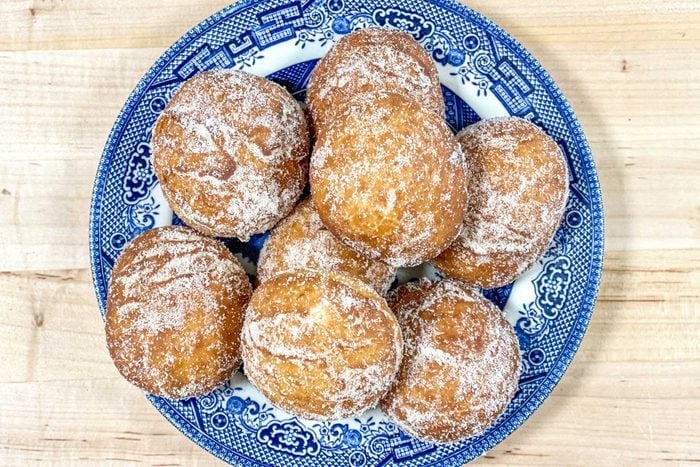
Originating from Portugal and now a popular Hawaiian treat, malasadas are a rich, eggy doughnut sprinkled in sugar.
On a long-ago trip to Honolulu, I made an excursion to Leonard’s Bakery to try their famous malasadas—an alternative take on the doughnut that originated in Portugal and later became popular in Hawaii. These treats are eaten all year round, but they’re especially associated with Mardi Gras, which some Portuguese and Hawaiian people call “Malasada Day.”
What Are Malasadas?
During Lent (the 40 days leading up to Easter), Catholics historically gave up decadent habits such as eating dessert. On Mardi Gras, the day before Lent begins, some Portuguese Catholics would make doughnuts to use up all of the lard and sugar in the house. They called the fried dough balls malasadas, which means, “poorly cooked.” The name is perhaps a reference to the combo of a golden-brown exterior and doughier interior.
In the late 1800s, an influx of Portuguese workers came to Hawaii to labor at the sugar plantations, and they brought their doughnut tradition with them. In 1952, the grandson of two of those Portuguese immigrants opened Leonard’s Bakery and began making malasadas. They were a hit, and the bakery is famous for them to this day.
How Are Malasadas Made?
Malasada dough comes together with milk, butter and eggs. The doughnuts have no holes, and are traditionally served unfilled and rolled in granulated sugar. In Hawaii, however, malasadas are often filled with tropical treats such as coconut pudding, guava cream or passion fruit curd.
Although malasadas sound similar to beignets (the French fried dough dessert popular in New Orleans) and both are served on Mardi Gras, the dough differs. Beignets are commonly made of pâte à choux (the type of dough used to make eclairs) that is cut into squares and fried. Malasadas, with their eggy, yeasted dough, are more similar to the German doughnuts known as Berliners, save for the fact that Berliners are filled with jelly. Who knew so many different kinds of doughnuts from around the world existed?
Malasada Recipe
This recipe is super flexible. I tried it with different amounts of yeast and flour, and different rising times, and the end product was lovely every time. When you make these, don’t stress too much about the details!
Ingredients
- 2/3 cup half-and-half
- 4 tablespoons unsalted butter
- 1 tablespoon instant yeast (not active dry yeast)
- 1/3 cup granulated sugar
- 3-1/2 cups all-purpose flour
- 3/4 teaspoon salt
- 3 large eggs
- Oil for frying, like grapeseed oil
- Additional sugar for garnish
Directions
Step 1: Prepare your liquids
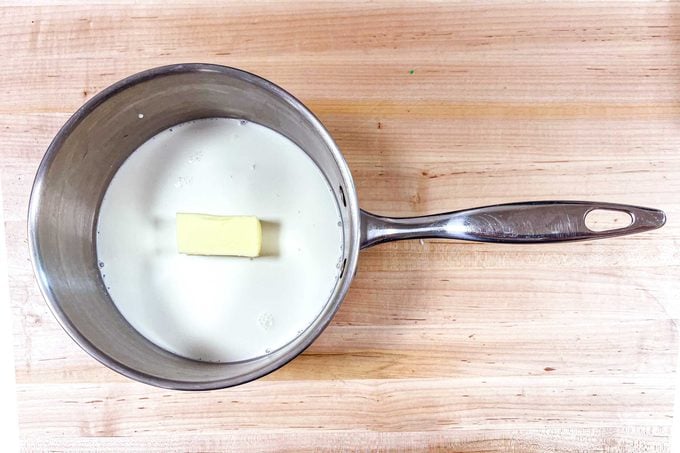
In a small saucepan, combine the half-and-half and butter, and heat until it just simmers. Turn down the heat and let stand on the burner.
Step 2: Mix up your dry ingredients
Meanwhile, in a mixing bowl (use the bowl for your stand mixer, if you have one), combine the yeast, sugar, flour and salt. If you’re using a stand mixer, put on the paddle attachment, and turn it to medium-low. If not, combine the ingredients by hand.
Step 3: Combine wet and dry ingredients
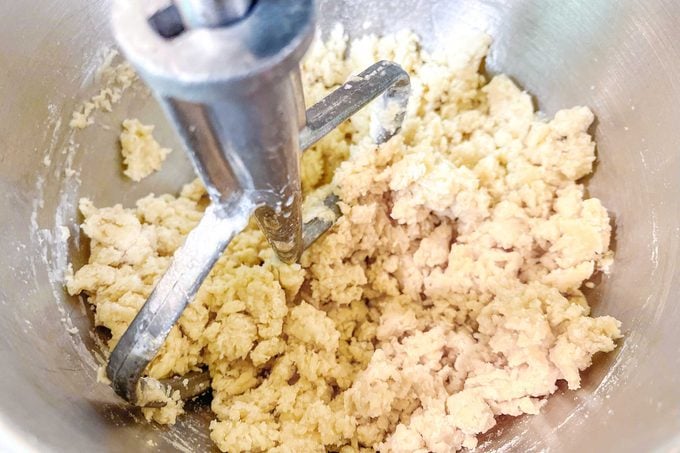
Once the dry ingredients are thoroughly mixed, add the warm butter and cream, and continue mixing until the wet ingredients are incorporated.
Step 4: Add eggs
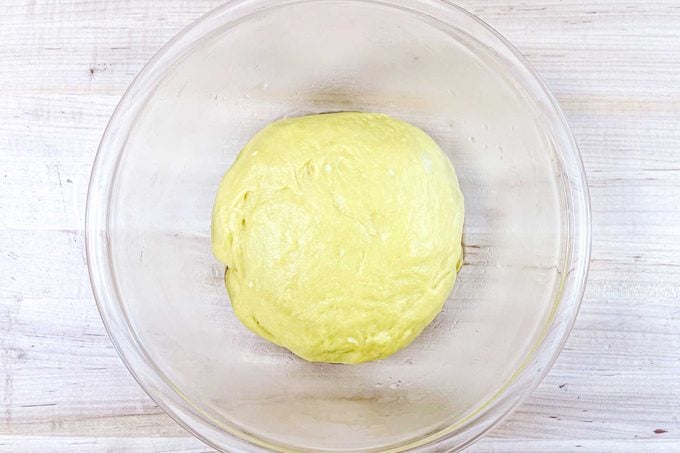
Crack one egg into a small bowl and ensure that it is good, then add it to the mixing bowl. Repeat with the remaining eggs. Beat until the mixture is smooth and elastic. If you’re using a mixer, you can use the medium or medium-high setting. Depending on the humidity and the size of your eggs, you may need to add more flour to get a smooth, but tacky to the touch, ball of dough.
Step 5: Let the dough rise
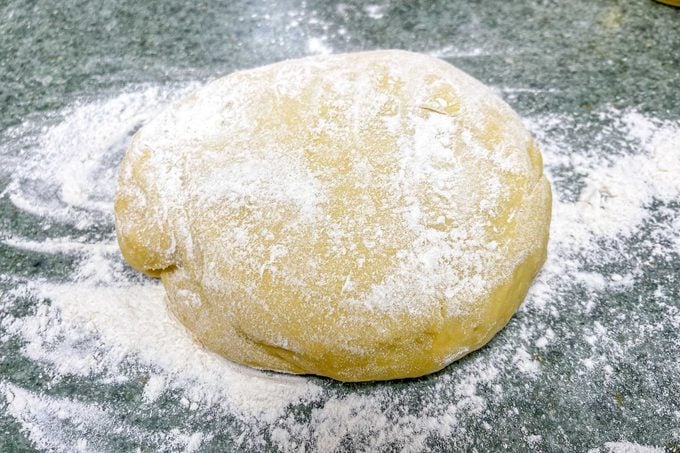
Scrape the dough out of your mixing bowl onto a lightly floured surface. Knead it a few times to form it into a smooth ball, and place it into a fresh, lightly oiled bowl. Cover the bowl and let the dough rise for 45 minutes or until doubled in size, whichever comes first.
Don’t bother cleaning up the counter because you’ll need a floured surface again later.
Step 6: Cut your doughnuts
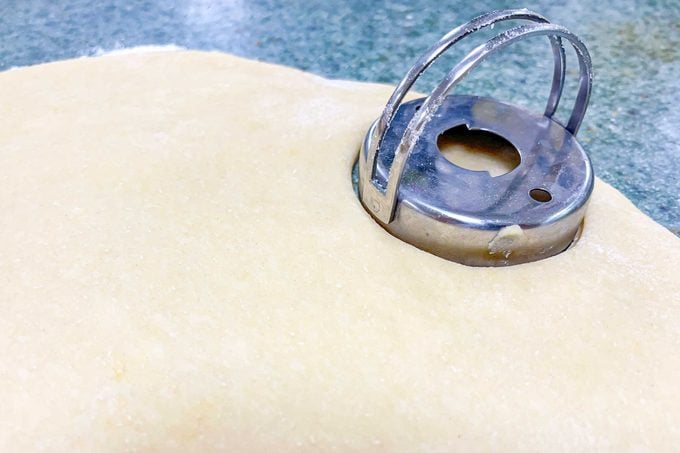
Dump the dough out of the bowl and onto your lightly floured surface, and dust the top with flour. Roll the dough out to approximately 1/2-inch, and cut it with a 2-1/2-inch cookie cutter. If you don’t have a cookie cutter, you can use a Mason jar, a drinking glass or another circular object. Don’t worry too much about getting the size exact. Place the cut malasada dough on a cookie sheet lined with parchment paper. Let rise for 15 more minutes.
Step 7: Prepare to fry
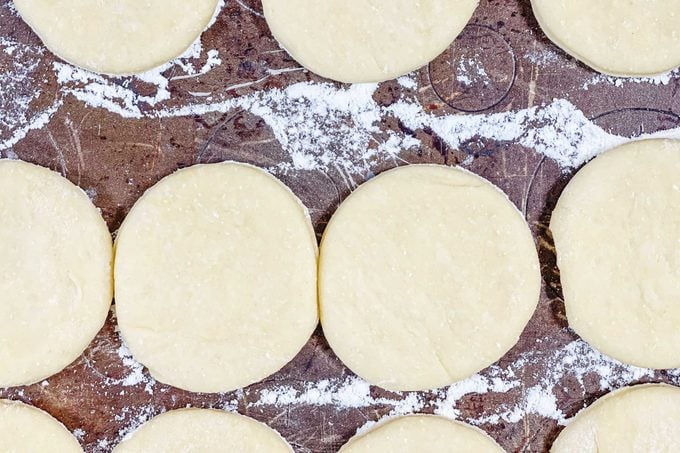
While the doughnuts are rising, prepare your frying station. Pour frying oil into a heavy-bottomed saucepan that’s at least 12 inches in diameter—you’ll want about 1 inch of oil in the pot—and put the pot over medium heat. Make sure you have a high-heat thermometer and a slotted spoon or skimmer nearby.
Cover a wire rack with paper towels, and set it up so that you can place malasadas onto it as they come out of the oil. Finally, pour granulated sugar onto a plate for dipping.
Editor’s Tip: I like frying with grapeseed oil, but any neutral oil with a high smoke point will work.
Step 8: Fry the doughnuts
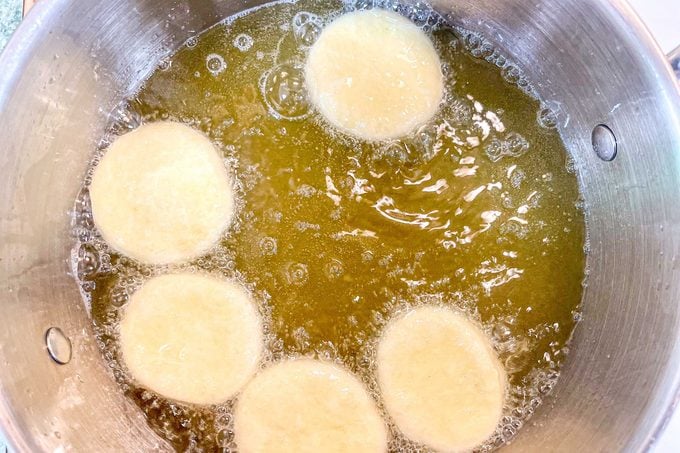
Check your oil temperature frequently. You will want it to be around 350°F when you cook the doughnuts. If it’s heating up too quickly, turn down the heat. If the doughnuts have risen before the oil is ready, that’s OK. When the oil reaches the correct temperature, start a 1-minute timer and add your first six malasadas, one at a time. I like to hold the dough round just above the hot oil, and let it slip in gently.
The oil temperature will drop when you add the dough, and you’ll want to turn the temperature back up toward 350° but doesn’t continue rising above that. This can take some regular adjusting of the heat.
Step 9: Flip the doughnuts
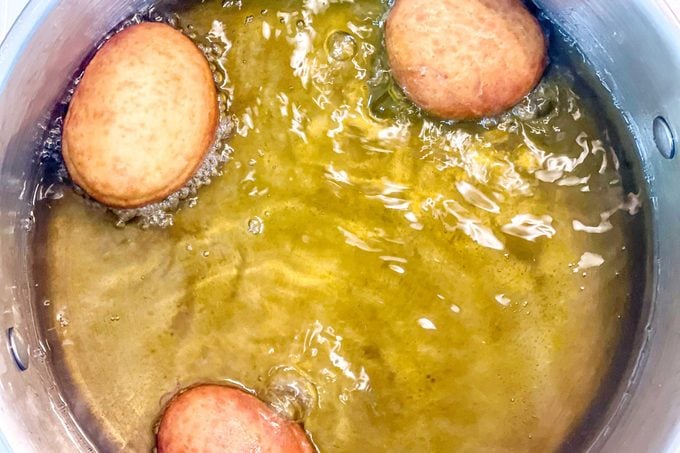
When the timer goes off, start it again, and carefully flip the doughnuts using your slotted spoon or skimmer. They should be between golden brown and chestnut colored. If they are lighter or darker, you’ll want to keep a closer eye on the oil temperature.
If the doughnuts are richly colored when the second timer goes off, use the slotted spoon to remove them to the paper towel-lined rack. If not, keep cooking, flipping as needed, until they are. It should only take a few more seconds.
Step 10: Finish frying
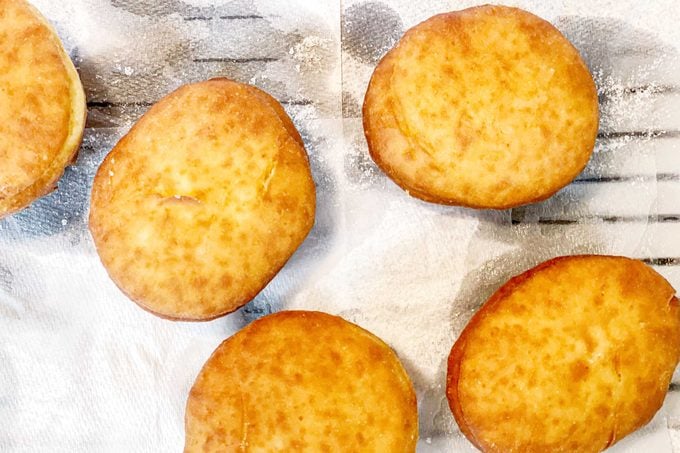
Continue cooking batches of doughnuts as described above. While the new doughnuts are frying, roll the slightly cooled doughnuts in granulated sugar so that all sides are lightly coated.
Step 11: Clean up
When all of the doughnuts are done, let your oil cool completely. If you’d like to keep it for a future cooking project, pour it through a strainer (or a coffee filter if you want to be super thorough) to remove any bits of food, and store it in a cool, dark place or in the fridge until you need it.
If you’re going to get rid of it, make sure you know how to dispose of oil safely.
Tips for Making Malasadas
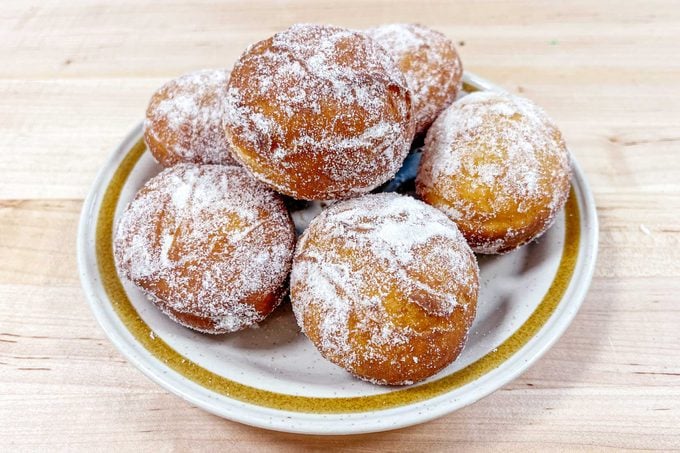
Can you fill malasadas?
Yes! Even though they’re traditionally not filled, Leonard’s Bakery in Hawaii sells filled versions. Try using a flavored pastry cream or a fruit curd. Fill a piping bag, fit it with a round tip, and insert the filling directly into the center of the malasada.
What toppings can you roll malasadas in?
Plain sugar is classic, but you can experiment by adding sprinkles and spices to the sugar: cinnamon sugar is an obvious choice, but nutmeg or allspice would also be lovely. A touch of cocoa or espresso powder would be great too. You could even bring the heat and use smoked salt or cayenne. For a fancy, shimmery look try luster dust, a tasteless food-grade glitter.
How should you store malasadas?
Malasadas are meant to be eaten warm. If you need to save unfilled malasadas, you can store them in an airtight container on the counter. Reheat them before eating. Filled malasadas should be stored in the fridge and should not be reheated before eating.
